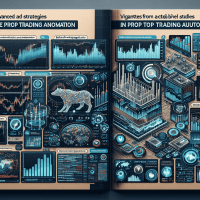Proven Prop Trading Automation Strategies for Peak Performance
In today’s competitive prop trading environment, the ability to automate trading strategies and conduct robust backtesting is indispensable. Prop trading automation is not just about running historical data – it’s about leveraging advanced tools, mitigating biases, and streamlining risk management to achieve optimal performance. This comprehensive guide delivers expert insights, tool comparisons, and actionable tips for traders, quants, and risk managers.
Understanding Prop Trading Automation
Prop trading automation transforms traditional trading by seamlessly integrating real-time data feeds, algorithmic execution, and sophisticated risk controls under a unified system. The primary goals are to optimize performance, execute strategies with minimal manual intervention, and ensure compliance with evolving regulations such as MiFID II and NFA rules.
What is Prop Trading Automation?
Prop trading automation involves using software and platforms to execute proprietary trading strategies without the delays caused by manual processes. Advanced backtesting features play a critical role, helping firms validate and optimize their trading algorithms using historical data. The integration of automation in trading also enables walk-forward analysis, scenario stress testing, and out-of-sample testing, essential for mitigating common pitfalls such as overfitting and survivorship bias.
Key Benefits for Prop Trading Firms
- Rapid strategy validation and faster execution cycles.
- Enhanced risk management through automated monitoring.
- Scalability and team collaboration benefits, ideal for both junior traders and seasoned quants.
- Compliance with regulatory frameworks and operational efficiency.
Advanced Backtesting Techniques for Prop Trading
One of the critical pillars of a successful prop trading automation system is a robust backtesting mechanism. Advanced backtesting goes beyond merely running historical data; it involves a careful analysis of data quality, including adjustment for corporate actions, and multiple testing techniques to mitigate biases.
Common Pitfalls in Backtesting
Several biases can skew the results of backtesting:
Overfitting: Excessively optimizing your strategy for historical data may cause poor live performance.
Survivorship Bias: Relying on a dataset that only includes surviving assets can create unrealistic expectations.
Look-Ahead Bias: Including future data inadvertently during backtests invalidates results.
Data Snooping: Excessive testing on the same dataset without sufficient out-of-sample validation can be dangerous.
Innovative Techniques: Walk-Forward and Out-of-Sample Testing
Walk-forward optimization and out-of-sample testing are at the cutting edge. Walk-forward analysis continually adjusts the model as new data emerges, ensuring more realistic performance metrics. Meanwhile, out-of-sample tests are essential for assessing the strategy’s robustness before finalizing deployment.

Figure 1: A backtesting report screenshot from TradingView, showcasing detailed performance metrics including Sharpe ratio and drawdown analysis.
Critical Tools for Prop Trading Automation and Backtesting
In prop trading, choosing the right tool is crucial. Let’s explore several widely recognized platforms, their features, and how they enhance the automation process.
TradingView
TradingView offers advanced charting with vectorized backtesting features. Its event-driven backtesting capabilities and integration with APIs make it ideal for rapid prototyping and validating strategies. The platform supports commission and slippage adjustments, and the community-driven library ensures constant improvements. Free and trial options are available, making it suitable for both retail and prop firm environments.
MetaTrader 5 (MT5)
MetaTrader 5 provides a robust environment for algorithmic trading with an emphasis on automated expert advisors. Its backtesting environment supports multi-threading, enabling efficient testing across various asset classes. The platform allows commission and variable spread simulation, offering a realistic market scenario. With a free demo version and multiple pricing tiers for enhanced features, MT5 is preferred by traders with varying experience levels.
NinjaTrader
NinjaTrader is notable for its advanced backtesting framework that supports event-driven simulations and vectorized methods. It excels in data quality and integration capabilities, including broker integration and third-party analytics plugins. Advanced optimizations and scenario-analysis features are vital for prop firms looking to manage team-based strategies.
Comparison Table of Top Tools
| Feature | TradingView | MetaTrader 5 | NinjaTrader |
|---|---|---|---|
| Backtesting Type | Vectorized, Event-driven | Multi-threaded, Simulated | Event-driven, Vectorized |
| Data Quality | High; community driven updates | Comprehensive; multiple asset classes | Excellent; reliable historical data |
| Integration | API Access, Broker Integration | Expert Advisor API, Broker linkage | Third-party plugins, Custom APIs |
| Pricing & Trial | Free and Paid tiers | Free demo available, tiered pricing | Competitive pricing, free trials |
| Use Case | Retail to Prop Firms | All scales, strong for institutional trading | Ideal for team collaboration in prop firms |
Integrating Backtesting Findings with Live Trading Strategies
Transitioning from backtesting to live deployment requires diligent integration of forward testing, often in the form of paper trading before real capital is risked. Key metrics to monitor include the Sharpe ratio, maximum drawdown, and profit factor. It is crucial to update risk management parameters in real-time based on market volatility and unexpected events.
Actionable Steps for Seamless Transition
- Paper Trading: Simulate live conditions with a dedicated demo account to validate assumptions.
- Risk Calibration: Adjust stop-loss levels and diversify strategies based on stress tests.
- Iterative Feedback: Use automated parameter optimization features provided by platforms like NinjaTrader to refine strategies continuously.
- Forward Integration: Merge backtesting results with live market signals for dynamic strategy tuning.

Figure 2: MetaTrader 5’s automated trading interface illustrating forward testing metrics and real-time analytics.
Real-World Case Study: Backtesting in Action
Consider a leading European prop trading firm that integrated automated backtesting tools into their daily workflow. Their strategy included a mix of momentum and mean-reversion approaches, thoroughly optimized using walk-forward analysis. The firm experienced a 15% improvement in Sharpe ratio and a 20% reduction in drawdown after integrating backtesting results with live paper trading results. This case study highlights how automation not only speeds up the validation process but also significantly enhances strategy reliability.
Key Takeaways
- Enhanced Metrics: Through automated report generation, strategies were fine-tuned to maintain a profit factor above industry benchmarks.
- Reduced Iteration Times: Automated parameter optimization cut down the feedback loop, resulting in more agile strategy adjustments.
- Risk Management: Integrated risk checks helped manage volatility, addressing regulatory requirements under frameworks like MiFID II.
Expert Guidance: Risk Management and Compliance
Regulatory compliance is a major factor in prop trading. Firms must adhere to frameworks such as ESMA and NFA rules. Maintaining a robust risk management checklist is part of daily operations. Below is a Risk Management Checklist that can be directly adopted:
Risk Management Checklist
- Define maximum drawdown limits and ensure daily risk exposure is capped.
- Set stop-loss and take-profit levels based on volatility metrics.
- Regularly review and audit backtesting methodologies to mitigate biases.
- Implement scenarios for stress testing using historical crises data.
- Ensure all automated systems have fail-safes to prevent runaway losses.
For more in-depth insights, explore our internal piece on Advanced Risk Management for Traders and the guide on Regulatory Compliance in Prop Trading to enhance your knowledge further.
Conclusion
Prop trading automation is revolutionizing the trading floor by offering systematic, data-driven insights that reduce manual errors and enhance strategy performance. By leveraging robust backtesting tools, mitigating common pitfalls, and integrating continual learning from forward testing, both retail traders and institutional firms can achieve improved reliability and profitability. As of October 2023, these methods are not only innovative but necessary for any serious trader looking to navigate today’s dynamic markets.
Ready to elevate your trading game? Download our complete Risk Management Checklist and subscribe to our newsletter for more cutting-edge strategies in prop trading automation.







